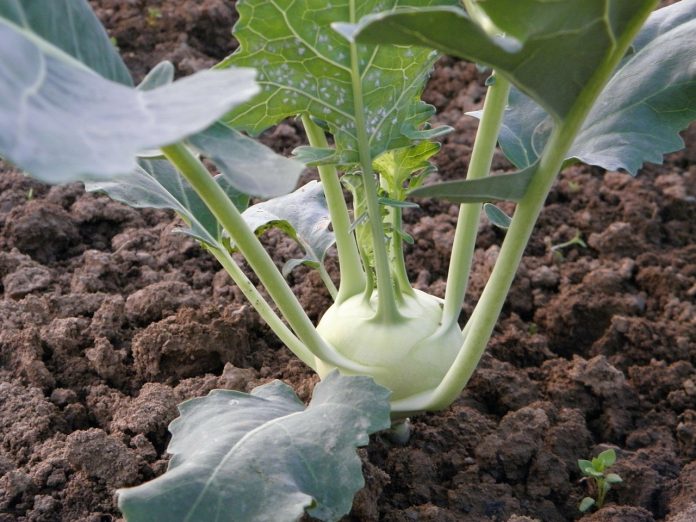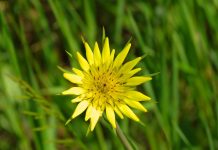A vegetable with the bulbous shape of the brassica family, the turnip cabbage is better known in Europe than in North America. With a sweet flavor, it is eaten raw or cooked. It has a delicious little taste of fresh hazelnuts. We tend to cook mostly the bulb, but the leaves and stems are also edible.
History of turnip cabbage
In the first century A.D., people “created” the turnip cabbage. Around the same time, in a region close to what is now Germany, people were interested in kale plants with short bulged stem. By dint of selection, one ends up getting a rod more and more bulged which, after a few centuries, leads to the form we know today.
Popular in Germany and northern Europe, the turnip cabbage is not consumed in Western European countries, where it is destined for breeding animals. Like the Jerusalem artichoke, the rutabaga and the turnip, it suffered during the last World War the backlash of a forced presence in the daily diet. Today, many people still refuse to consume it. In North America, despite timid efforts to make it known, it remains the unknown cabbage of the big cabbage family.
Health profile of the turnip cabbage
This vegetable is eaten raw or cooked. Like most of the crucifers, it contains bioactive compounds that would have beneficial effects to fight against different types of cancer. The cabbage is also an excellent source of vitamin C.
The benefits of turnip cabbage
Several epidemiological studies have shown high consumption of vegetables and fruit decreases the risk of cardiovascular diseases, some cancers and other chronic diseases. The presence of antioxidants in vegetables and fruits could play a role in this protection.
Cancer. Several studies have shown the regular consumption of vegetables in the family of the brassicas (for example, turnip cabbage, cauliflower, broccoli, Brussels cabbage may prevent certain cancers, such as those of the lung, ovaries and kidneys (for women).
Although recent articles review report vegetables from the family of the crucifers would have a specific protective effect on cancer risk, the current epidemiological evidence suggests eating vegetables from the crucifer’s family may reduce the risk of stomach and lung cancers. To date, however, it would be premature to conclude eating vegetables from the family of the crucifers decreases the risk of all types of cancers. Future work will need to be done to clarify this study.
In vitro and animal studies showed some active compounds contained in the cabbage (sulphoraphane and carbinol) could prevent the formation of tumors, decrease the growth of cancer cells and promote their self-destruction. These studies focus mainly on cancers related to the hormonal system (breast and prostate cancer), but other results among animals also show a beneficial effect against cervical cancer. In addition, it was observed sulforaphane had the ability to destroy H. Pylori, a bacterium which could infect the stomach and cause ulcer and cancer among humans. However, further research is needed before confirming these results among humans. Considering the data currently available in the scientific literature, it appears a frequent consumption of vegetables from the family of the crucifers decreases the risk of metastases among some people who have developed a tumor.
Cardiovascular health. Daily consumption of brassicas would be associated with a lower blood concentration of homocysteine, which would reduce the risk of cardiovascular diseases.
Memory. A study conducted among older women concluded the consumption of brassicas would slow the cognitive decline.
What’s in the turnip cabbage?
Glucosinolates
Like the majority of the brassica vegetables, the cabbage contains glucosinolates. Cabbage glucosinolates have the ability to transform into active molecules (sulphoraphane, carbinol, and 3,3′-diindolylmethane) when the food containing it is chopped, cheweded or in contact with the bacterial intestinal flora. Many of these molecules would help to limit the development of some cancers. The cooking of turnip cabbage causes a loss of glucosinolates, so a moderate cooking would optimize the formation of bioactive compounds. To date, however, the optimum therapeutic concentration of these compounds has not yet been evaluated among clinical studies.
Precautions
Irritable bowel syndrome. Some people with irritable bowel syndrome can feel, in varying degrees, intolerance to the crucifers, such as the turnip cabbage. Limiting or avoiding fermentable foods such as those in the brassica family may alleviate symptoms (abdominal pain, bloating, diarrhea) among people with this syndrome. When the symptoms are mild, or during “remission”periods, it’s sometimes possible to gradually reintegrate these foods, always respecting individual tolerance.
Interaction between the turnip cabbage and certain medications. The indoles, naturally occurring compounds in the brassicas may decrease the action of some analgesics such as products containing acetaminophen (Tylenol, Atasol, Tempur) and other medications combining a mixture of active ingredients (Benylin, Contac, Robaxacet). People who consume a large amount of brassicas are invited to take this aspect into consideration.
Is there a link between the turnip cabbage and thyroid cancer?
The turnip cabbage naturally contains thioglucosides, substances that would have a connection with thyroid gland cancer among animals. Now, a meta-analysis of studies from many countries and comprising more than 5 000 people, as well as a journal article containing epidemiological studies, showed that high consumption of brassicas was not associated with a greater risk of thyroid cancer among humans.
Choice and conservation
Choose
Preferably choose from turnip cabbage from 5 cm to 7 cm in diameter. Bigger, they may be fibrous. Miniatures (2 cm or 3 cm), they will be cooked whole, with their skin.
The cabbage leaves are eaten like spinach or turnip greens.
Keep
Refrigerator. Put them two by two in a plastic bag, preferably pierced.
Freezer. Cut them in dice, blanch three minutes and cool with icy water.
Lactofermentation. Make it a sauerkraut.
Organic gardening
The cauliflower likes cool temperatures and therefore prefers to be grown in the spring and fall. However, in the spring, it should not be put in the ground until the temperatures have stabilized and reached 15 °C. Otherwise, it may be prematurely mounted in seed.
Although all members of the brassica family are susceptible to cabbage fly, root or near-root vegetables such as cauliflower are particularly exposed. It is in the root of the plant the larvae settle down and dig their tunnels, making the vegetable very unappetizing. In the garden, the combination of lettuce and cauliflower has the effect of significantly diminishing the attacks of cabbage flies which do not like lettuce smell. You should sow these two vegetables alternating.


















